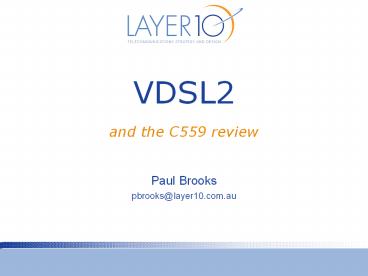VDSL2 PowerPoint PPT Presentation
Title: VDSL2
1
VDSL2
- and the C559 review
Paul Brooks pbrooks_at_layer10.com.au
2
Timeline for xDSL
Feb 2006-2007
ADSL1 initially developed by ATT/Bell Labs in
1989 to deliver video predates the development
of WWW
2003-2007
2002,2005-2007
2003
1999-2003
3
Why?
4
Agenda
- DSL Redux
- ADSL 2
- VDSL2 compared
- VDSL2 Bandplans
- VDSL2 benchmarks
- Bonding Packet Transfer Mode
- DSM Dynamic Spectrum Management
5
ADSL2
- 512 tones
- 25 tones upstream
- 473 tones downstream
- max 60kbps per tone
- Frequency band up to 2.2 MHz
6
VDSL2
- Several Band-plans
- 7200 tones (up to 30MHz)
- 3 upstream bands
- 2 or 3 downstream bands
- Same encoding and signalling per tone - 60 kbps
- Frequency band up to 12/17/30 MHz
VDSL2 is effectively ADSL2
7
Several Bandplans(1)
B8-4 is a 998 plan. B7-5 is a 997 plan
- Its not as simple as 997 bandplans are more
symmetric, 998 bandplans are more asymmetric..
B8-4
B7-5
B7-5
B8-4
Assumptions 12 MHz band plans PIUT 40 revised No
UPBO 9 x VDSL2 equal length
(Example - C559 VDSL2 working group benchmark
illustration only!)
8
Several Bandplans(2)
- G.993.2 02/2006
- Annex A (US) 9 plans based on Annex M ADSL2
- Annex B (Euro) 6 x 997 plans and 7 x 998
plans up to 12 MHz
- Annex C (Japan) 1 band plan over ISDN, up to 30
MHz
- Annexes D, E, F, G, H, I, J, K all for further
study
But waittheres more
9
Several Bandplans(3)
- G.993.2 Amendment 1 Nov 2006 draft
- Annex A (US) 8 downstream x 11 upstream (some
not compatible with each other) 80 plan
variations, with max at 8/12/17/30 MHz
Exercise Pick One (1) only bandplan for use
throughout Australia
- Annex B (Euro) 10 x 997 plans and 16 x 998
downstream plans up to 8/12/17/30 MHz
- Annex C (Japan) 4 minor band plan variants, up
to 30 MHz
This VDSL2 stuff is very fresh!
10
Ob-Disclosure
- Communications Alliance C559 Deployment Rules
Review - Layer10 representing
- Preliminary information is from working drafts
subject to change before publication.
11
Multiple Bandplans dont coexist
- Frequencies that one line uses for upstream, and
another line uses for downstream, interfere and
destroy each other - Overall performance drops to lowest common
denominator for both - Every service must use the same tones for
upstream and downstream, without overlap - All must use the same bandplan
12
Bandplan Choice
- Chosen Bandplan isEuropean Annex B 998 Plan
B8-11 to 17 MHz(from Amendment 1 still to be
completed)
- Little/No benefit to go to 30MHz, but 17 MHz
provides good speed out to 600m - 998 plan maximises downstream capacity for IPTV,
Internet content downloads - Still retains good upstream (5-20 Mbps at 800m)
upstream capacity meets or beats eSHDSL symmetric
services at all distances
13
VDSL2 Deployment Classes
- ADSL2 Deployment Classes
- 6h ADSL2 (Annex A) (unlimited distance)
- 6j ADSL2 Annex M EU-40
- 6k ADSL2 Annex M EU-52
- 6l ADSL2 Annex M EU-56
- 6m ADSL2 Annex M EU-60
- 6n ADSL2 Annex M EU-64
- VDSL2 Deployment Classes
- 10h VDSL2
- 10j VDSL2 Annex M EU-40 in US0 upstream
- 10k VDSL2 Annex M EU-52 in US0 upstream
- 10l VDSL2 Annex M EU-56 in US0 upstream
- 10m VDSL2 Annex M EU-60 in US0 upstream
- 10n VDSL2 Annex M EU-64 in US0 upstream
- NOT any of the further Annex M-like EU-XX
beyond EU-64
14
VDSL2 Benchmarks
- Benchmark 10h modelled worst-case performance
Preliminary Only Do Not Rely On These!
15
/end C559
- Back to ITU-T G.993.2
- (but still subject to amendments!)
16
Other VDSL2 tricks
- Bonding
- 2 8 parallel VDSL2 services together, acting as
a single channel (needs compatible CPE) - 80 Mbps upstream, 640 Mbps downstream anyone? ?
- Packet Transfer Mode (PTM)
- Ethernet-in-the-first-mile (EFM) 802.3ah framing
is supported natively - no more fiddling with ATM PVCs in the DSLAM or
modem required - 5 increased performance from reduced overheads
17
DSM
- Dynamic Spectrum Management
- Adjusts transmit power in each line to
time-variable external crosstalk, to optimise
bandwidth for all lines in the binder by reducing
cross-talk - No DSM (current situation) assumes each line is
greedy worst-case modelling leads to
conservative performance - DSM Level 1 static spectrum shaping to avoid
crosstalk each line tries to optimise PSD shape
and be polite in isolation - DSM Level 2 dynamic spectrum shaping each
line talks to neighbours and all optimise PSD to
try to be polite - DSM Level 3 MIMO cross-talk cancellation
reverse crosstalk signal calculated and added in
real-time to cancel out at the far end
18
DSM Level 2
- Algorithms developed fairly recently
- Iterative Water-Filling (2002)
- Optimal Spectrum Balancing (2004)
- Iterative Spectrum Balancing (2005)
- Autonomous Spectrum Balancing (2006)
- Not available from DSLAM vendors currently,
although some are preparing products and
management systems to support DSM.
19
DSM Level 2
20
DSM Level 3
- Full MIMO Crosstalk Cancellation
- Ask Dr John Papandriopoulosin about 3 5 years
21
Wrapup
- Its easy to offer 50Mbps access lines, if you
know the top 40 Mbps will never be able to be
used
Me.
- Great access network speeds are one thing be
careful the backhaul can feed the access or
there is local-enough content to avoid using the
backhaul
22
VDSL2 wont solve everything
- Some problems will be made worse by VDSL2
23
Thank you
- pbrooks_at_layer10.com.au
www.layer10.com.au

